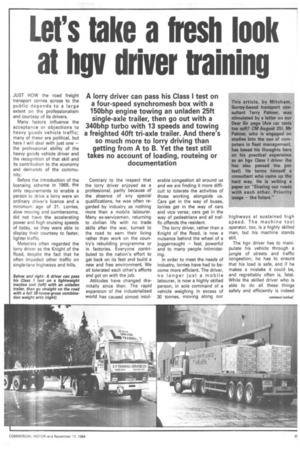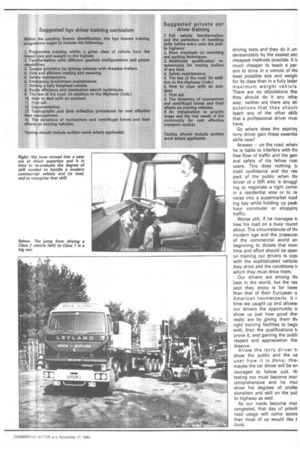Let's take a fresh look at hgv driver training
Page 71

Page 72

Page 73

If you've noticed an error in this article please click here to report it so we can fix it.
A lorry driver can pass his Class I test on a four-speed synchromesh box with a 150bhp engine towing an unladen 25ft single-axle trailer, then go out with a 340bhp turbo with 13 speeds and towing a freighted 40ft tri-axle trailer. And there's so much more to lorry driving than getting from A to B. Yet the test still takes no account of loading, routeing or documentation
JUST HOW the road freight transport comes across to the public depends to a large extent on the professionalism and courtesy of its drivers.
Many factors influence the acceptance or objections to heavy goods vehicle traffic; many of these are political, but here I will deal with just one — the professional ability of the heavy goods vehicle driver and the recognition of that skill and its contribution to the economy and demands of the community.
Before the introduction of the licensing scheme in 1969, the only requirements to enable a person to drive a lorry were an ordinary driver's licence and a minimum age of 21. Lorries, slow moving and cumbersome, did not have the accelerating power and high cruising speeds of today, so they were able to display their courtesy to faster, lighter traffic.
Motorists often regarded the lorry driver as the Knight of the Road, despite the fact that he often impeded other traffic on single-lane highways and hills. Contrary to the respect that the lorry driver enjoyed as a professional, partly because of the absence of any special qualifications, he was often regarded by industry as nothing more than a mobile labourer. Many ex-servicemen, returning to civilian life with no trade skills after the war, turned to the road to earn their living rather than work on the country's rebuilding programme or in factories. Everyone contributed to the nation's effort to get back on its feet and build a new and free environment. We all tolerated each other's efforts and got on with the job.
Attitudes have changed dramitally since then. The rapid expansion of the industrialised world has caused almost intol erable congestion all around us and we are finding it more difficult to tolerate the activities of those working alongside us. Cars get in the way of buses, lorries get in the way of cars and vice versa; cars get in the way of pedestrians and all traffic offends the resident.
The lorry driver, rather than a Knight of the Road, is now a nuisance behind the wheel of a juggernaught — fast, powerful and to many people intimidating.
In order to meet the needs of industry, lorries have had to become more efficient. The driver, no longer just a mobile labourer, is now a highly skilled person, in sole command of a vehicle weighing in excess of 30 tonnes, moving along our highways at sustained high speed. The machine tool operator, too, is a highly skilled man, but his machine stands still.
The hgv driver has to manipulate his vehicle through a jungle of streets and traffic congestion; he has to ensure that his load is safe, and if he makes a mistake it could be, and regrettably often is, fatal. While the skilled driver who is able to do all these things safely and efficiently is indeed a very skilled person, how many of us recognise this?
The move to license drivers of heavy goods vehicles was a major step in the right direction in promoting and encouraging a degree of professionalism in lorry driving, but that was 15 years ago.
Since 1969 the pressure placed upon the transport industry has necessitated more powerful, higher payload vehicles. The once very popular Gardner 180 plodder has gradually given way to the high output, turbocharged supertrucks with splitter gearboxes and overdrives.
It used to be said that you could roll a hand-made cigarette between gear shifts on a lorry. With the low rate of acceleration and delayed gear changes, lorry driving was more leisurely and the driver had more time to think about what he was doing; he had, among other things, time to be courteous.
Now the story is not quite the same. The driver has to snatch gears through a 13-speed constant-mesh gearbox, keeping his engine at maximum torque through double the rpm at the same time as making allowances for high performance private cars and irritated drivers. He no longer has time to think about what he is doing; he most react and drive his vehicle on his instincts and with perfect co-ordination.
We have moved into a new era of driver expertise and it is time to re-evaluate the degree of skill needed to handle a modern commercial vehicle and its load, and to recognise that skill.
Today there are four categories of hgv licence as follows: Class 1: An articulated vehicle other than a vehicle in Class 4. Class 2: A heavy goods vehicle, other than an articulated vehicle, designed and constructed to have more than four wheels in contact with the road surface.
Class 3: A heavy goods vehicle, other than an articulated vehicle, designed and constructed to have no more than four wheels in contact with the road surface.
Class 4: An articulated vehicle the tractive unit of which does not exceed the unladen weight of two tonnes.
These groups are further divided into vehicles with or without automatic transmissions.
The jump from driving a car to a lorry in the old days was indeed a big one. The jump from driving a Class 3 vehicle to a Class 1 is a big one, and one that the hgv licensing scheme to all intents and purposes fills, but does it go far enough for today's sophisticated trucks and the extreme pressures of modern driving conditions?
Many factors are still not taken into account when assessing a person's driving ability under the hgv licensing and testing programme. For example: A driver passing a test on a Class 1 vehicle fitted with a four-speed synchromesh gearbox and a 150bhp engine and towning an unladen 25ft singleaxle trailer will be qualified to go straight out onto the public highway with 340bhp turbocharged tractive unit fitted with 13-speed constant-mesh splitter gearbox and towing a fully freighted 40ft tri-axle trailer and with a gross combination weight of 38 tonnes. That jump is bigger than it was to go from a lorry to a car in the old days.
Further still, there is no provision for the instruction or testing on the safe loading and securing of 20-odd tonnes of freight, safety maintenance, routeing, the law, documentation, and so on. There is much more to lorry driving than just getting the vehicle from A to B. Valuable time can be lost and unnecessary congestion caused if a driver lacks the abilityto find the most cost effective and acceptable route or to load his vehicle efficiently and safely.
Again, referring back to days past, potential drivers were trained in their skills first by working as a driver's mate. The driver's mate was able to learn from his driver how to rope and sheet a load, how to nest it in so it did not have to settle too much or move in transit and how to find his way around. That's all in the past; we rarely have a driver's mate" any more.
Enterprising agencies have sprung up in recent years to train drivers to pass the hgv
driving tests and they do it understandably by the easiest anc cheapest methods possible. It iE. much cheaper to teach a person to drive in a vehicle of the least possible size and weight for its class than in a fully lader maximum weight vehicle There are no stipulations thai they should do it any othei way; neither are there any sti. pulations that they shoulc teach any of the other skill: that a professional driver mus. have.
So where does the aspirin( lorry driver gain these essentia skills now?
Answer — on the road, wherE he is liable to interfere with thE free flow of traffic and the gen eral safety of his fellow roac users. This does nothing tc instil confidence and the res pect of the public when thE driver of a 50ft attic is struggl ing to negotiate a tight come' in a residential area or to re verse into a supermarket load ing bay while holding up peak hour commuter or shoppin( traffic.
Worse still, if he manages tc lose his load on a busy round about. The circumstances of thE modern age and the pressure: of the commercial world an beginning to dictate that mon time and effort should be spen on training our drivers to cop( with the sophisticated vehicle( they drive and the conditions ir which they must drive them.
Our drivers are among thr best in the world, but the res pect they enjoy is far lowe than that of their European 0 American counterparts. It I: time we caught up and &lower our drivers the opportunity tc show us just how good the really are by giving them thi right training facilities to begir with, then the qualifications t( prove it, and gaining the publi respect and appreciation the deserve.
Allow the lorry driver tl show the public and the ca user how it is done, the( maybe the car driver will be en couraged to follow suit. Hi testing too must become mor comprehensive and he MUE show his degrees of profeE sionalism and skill on the put lic highway as well.
As our roads become mor congested, that day of priorit road usage will come soonE than most of us would like t think.












































































































